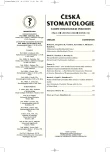Our Contribution to Semipermanent Splinting
Náš příspěvek k semipermanentnímu dlahování
Vláknové kompozity mají v zubním lékařství mnohostranné využití. Jednou z možností jejich klinických aplikací je dlahování zubů v průběhu léčby pulpoparodontálních onemocnění. Pokročilá stadia pulpoparodontálních postižení vyžadují komplexní přístup – endodontické ošetření spolu s léčením parodontu. Uvedená postižení jsou provázena viklavostí zubu, která se v průběhu parodontologické fáze léčby může přechodně ještě zhoršit. Proto je indikováno dlahování již před započetím terapie.Autoři uvádějí postup při zhotovení krátkých dlah z vláknového kompozitu DentapregTM a prezentují vlastní zkušenosti s 12 dlahami ve frontálním úseku. Dlahy byly aplikovány před zahájením komplexní endodonticko-parodontologické léčby a ponechány se souhlasem pacienta in situ do stabilizace onemocnění. Z 12 dlah se po uplynutí 3 měsíců uvolnily 2, ostatní zůstávají v ústní dutině. Nejdelší doba začlenění je 2 roky, nejkratší 3 měsíce.
Klíčová slova:
pulpoparodontální onemocnění – vláknové kompozity – dlahy – semipermanentní dlahování
Authors:
L. Roubalíková 1; J. Jančář 2; Z. Šedivý 2
Authors‘ workplace:
Stomatologická klinika LF MU a FN U Sv. Anny, Brno
přednosta prof. MUDr. J. Vaněk, CSc.
1; Ústav chemie materiálů VUT, Brno
ředitel prof. RNDr. J. Jančář, CSc.
2
Published in:
Česká stomatologie / Praktické zubní lékařství, ročník 106, 2006, 6, s. 105-110
Category:
Overview
Fiber composites have multiple uses in dental medicine. Possible clinical applications include the application of splints in the course of therapy of pulpoperiodontal diseases. Advanced stages of pulpoperiodontal affections require a complex approach – endodontic treatment together with the treatment of periodontium. In the described affection the tooth tends to be loose and this condition tends to deteriorate, though often transiently. That is why splints are indicated already before the beginning of the treatment. The authors describe the procedure encountered in making short splints from the fiber composite DentapregTM and present their own experience with 12 splints in the frontal segment. The splints were applied before the beginning of a complex endodonticperiodontium therapy and remained with the consent of the patient in situ until the disease becomes stable. Two of the 12 splints became loosen after 3 months elapsed, but the other remained in oral cavity. The longest time period of integration was 2 years, the shortest one lasted 3 months.
Key words:
pulpoperiodontal disease – fiber composites – splints – semipermanent spinting
Labels
Maxillofacial surgery Orthodontics Dental medicineArticle was published in
Czech Dental Journal

2006 Issue 6
- What Effect Can Be Expected from Limosilactobacillus reuteri in Mucositis and Peri-Implantitis?
- The Importance of Limosilactobacillus reuteri in Administration to Diabetics with Gingivitis
Most read in this issue
- Inflammatory Myofibroblastic Tumor
- Distraction Exercise – a New Method for Conservative Treatment of Anterior Dislocation of Temporomandibular Joint Disc
- Our Contribution to Semipermanent Splinting
- Late Orthodontic Prosthetic Therapy with the Use of Delair Mask
